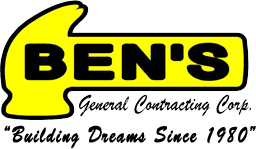New Commercial Building Construction Process
Have any questions about your new commercial construction project? Contact Ben’s General Contracting to speak with an experienced construction manager. Call (516) 623-2945 today!
The New Building Construction Process
Before Construction
Before you can begin your project, there are various elements that need to be handled in advance. Your journey should start at the property itself. It is important that you choose a lot that has the correct zoning for your type of building and all necessary utilities available. Once you have chosen your property, you should choose the correct type of design professional to tailor the building to your needs.
While engineers are more practical, mainly focusing on the building’s structure, architects can help detail the aesthetics of your building. In many cases, an interior designer can also play a helpful role in both the architectural and aesthetical aspects of a project, however, they usually need to be complemented by a professional that can draw detailed blueprints for the contractors to bid on.
Once the property is ready for construction and the design professional illustrates your vision on blueprints, it is time for contractors to bid on the job. You should be able to take each proposal and compare apples to apples. Additionally, you should make sure that the contractor has the resources and experience to handle your job with care and finish in a timely manner. Once you have chosen your commercial contractor, you are ready to begin construction.
The Project Begins…
 Groundbreaking: This is the first major step towards beginning construction on your project. You should have your property ready for a survey, clearing the lot, locating utilities, staking out the perimeter of the building and laying out the substructure for the foundation.
Groundbreaking: This is the first major step towards beginning construction on your project. You should have your property ready for a survey, clearing the lot, locating utilities, staking out the perimeter of the building and laying out the substructure for the foundation.
Concrete Work: Once the substructure is laid out, the concrete team begins to excavate the lot and pour concrete for the foundation. First, the deep foundation is rooted into the ground, usually using either footings or helical piles. Once the root is set, the team continues to pour the walls to bring the foundation up to grade, then a slab on top. All of this work is weather dependent; if the temperature is too low or ground conditions are too poor, the concrete team may have to make the necessary adjustments or simply wait for workable conditions.
Building the Structure: After a strong support system is built, the framing team can begin building your structure above grade. This includes framing walls, ceilings, and roof: the shell of the structure. The most important decision you will be faced with pertains to the type of materials used. Usually, owners usually use either on or a combination of the following: concrete, cement block, wood, steel or glass. Each material varies in both strength and aesthetics, as well as cost, so there is no “correct material”; it ultimately comes down to the look that you want at a price you can afford.
Finishing the Exterior: Once the structure of the building is constructed, the detail work begins. Usually the exterior is finished first, although the schedule may vary from job to job. At this time, owners must decide the type of finish they want. These include but are not limited to: cultured stone, stucco, storefront and metal paneling. Just as deciding on a structural material is a cost/benefit analysis, finish material is ultimately under the discretion of the owner. While some materials are more visually appealing, others simply attract the most attention. Depending on your buildings use, you can choose one or a combination of the aforementioned finish materials.
Finishing the Interior: The last major phase of the project is the interior work. It begins with mechanical teams installing all HVAC, plumbing, electrical, equipment, etc. After all mechanicals have been installed and run properly, the finish team begins the interior finish work. Some aspects of the finish work include flooring, wallpaper, seating, and installing lighting and plumbing fixtures. This phase deals with the most detail, as aesthetics and functionality can play large roles depending on the building’s intended use.
Closing Out
After the structure is completely built, there are a few tasks left to close the job out. At this point in time, there may be some site work left outside. This includes but is not limited to: grading, landscaping, drainage and installing blacktop, pavers, electrical fixtures and retaining walls. Additionally, you should work towards getting final surveys and inspections from the appropriate municipalities. Your contractor should help you coordinate and schedule these inspections with the town.
Lastly, after all work is done, the owner usually composes a “punch-list” which includes some minor adjustments that need to be made to the job. While this is not necessarily included in the contract, most upstanding contractors complete the list with little to no hassle.
Contact An Award-Winning Commercial Contractor Today
Ben’s General Contracting has over 30 years of experience successfully completing new construction, remodeling or renovation projects. We serve independent retailers and franchises for new commercial construction projects large and small. Contact us today to discuss your needs further at (516) 623-2945 or fill out this form and we will contact you properly.











